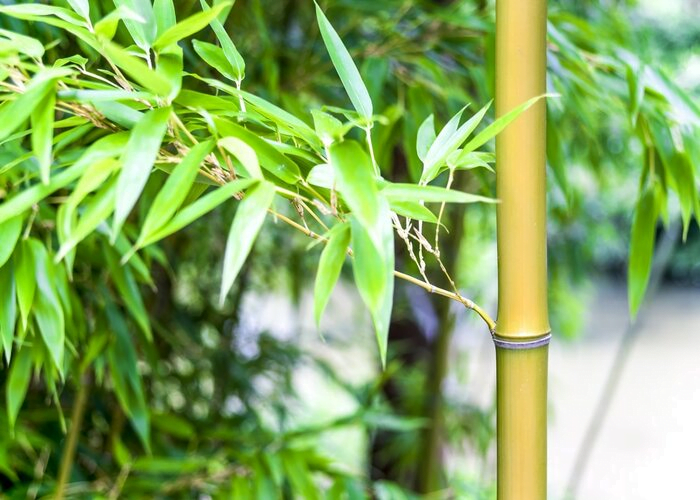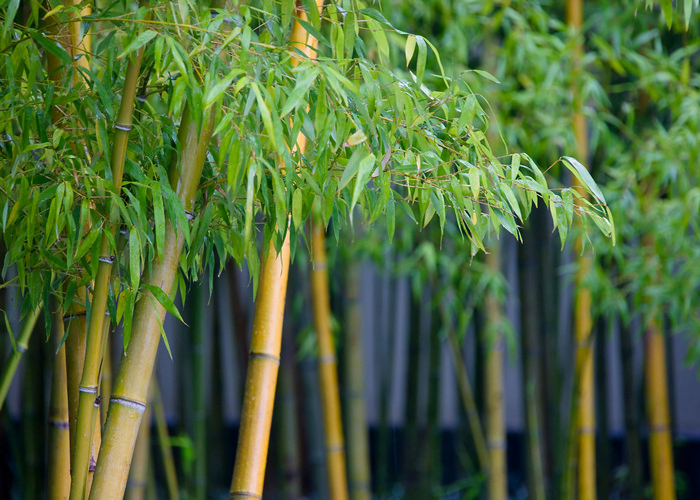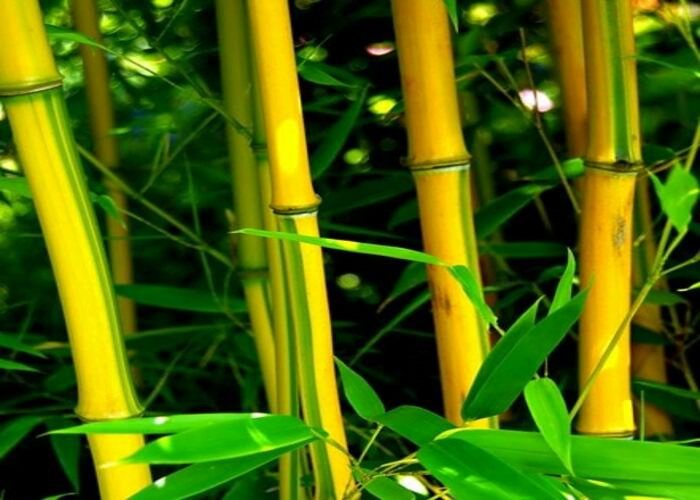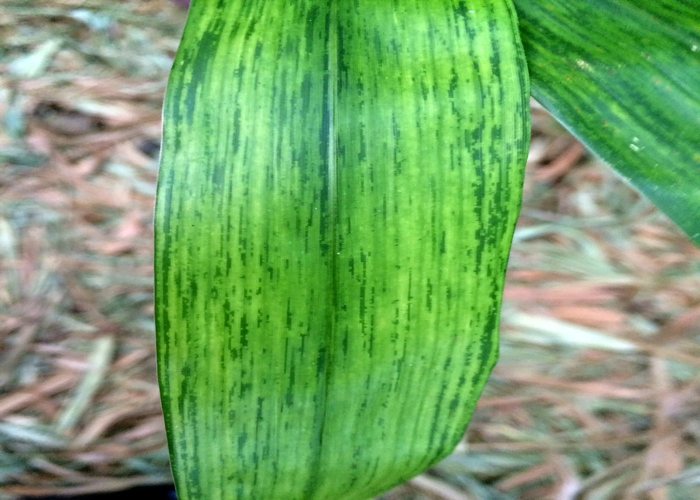When it comes to adding lush greenery to your place quickly, bamboo plants are a perfect choice. You can upgrade any place with the attractive cane with evergreen foliage.
Additionally, you do not have to worry about their maintenance since they are known for being hardy and low-maintenance plants.
Under the right conditions, they grow to heights of several meters. Ideally, you should plant them in spring, in the sun, and in moist but free-draining soil.
Furthermore, there are three easy methods by which you can propagate new bamboo plants. Division, rhizome cuttings, and seeds are the three methods.
If you are fascinated with bamboo plants, here is a detailed guide on bamboo plants. So, let’s explore this beauty in detail.
About bamboo plant

| Scientific name | Bambusa vulgaris |
| Common name | Feathery bamboo, Female bamboo, fernleaf bamboo, and fernleaf hedge bamboo |
| Family | Poaceae |
| Light | 6 hours of direct sunlight per day |
| Water | 3 – 4 times a week |
| Soil | Loamy and well-drained soil |
| Fertilizer | Slow-release fertilize |
| Toxicity | Non-toxic |
| Fun fact | Foliage of bamboo can contain up to 22% protein, so it’s even good for cats, dogs, and horse |
Types of Bamboo Plant
For people who have an inclination towards gardening and wish to manage superb plant options, the bamboo tree is the best option. Let us discuss some of the attractive lucky bamboo plant variants you can consider.
1. Giant Bamboo
Giant bamboo can acquire a maximum height of up to 100 feet. At present, giant bamboo is indeed the tallest bamboo tree type you have all around the globe. This version has sturdy culms that are almost 1 foot in circumference. The canes initially start with a chalky white covering, but the color changes to faded dark blue or pale green with age. Giant bamboo tree images are all over the internet, and you can find their existence familiar in China, Thailand, and Burma.
2. Umbrella Bamboo
Umbrella Bamboo is a versatile bamboo tree type cultivated for its non-invasive, easy-care, elegant, and adaptable characteristics. The yellow-green canes with narrow leaves are its prime appearance traits. Umbrella bamboo has fussy-looking foliage with a bright green top.
3. Chinese Fountain Bamboo
Chinese Fountain Lucky Bamboo is characterized by long & slender canes that heavily arch due to the foliage’s weight. The canes are colored medium green with light patches of blushing purple. Chinese bamboo tree has narrow foliage that offers a matte surface appearance. The best part about this plant is the toughness that allows it to withstand severe cold.
4. Japanese Timber Bamboo
Even though the bamboo tree is primarily native to China, this particular variety, called the Japanese timber bamboo, is extensively found across Japan and harvested mainly for timber. Japanese timber bamboo has canes that are smooth and glossy. You can even see this bamboo plant in a dazzling shade of bright emerald green or green-yellow (with aging).
5. Black Bamboo
Black Bamboo (Phyllostachys Nigra) is almost similar to fountain bamboo but has feathery leaves with jet black culms. With such character traits, it gets its name ‘Black Bamboo’. This bamboo variety is found in the Hunan Province of China.
How to grow a bamboo plant

Let’s begin by learning how to grow this plant. To grow a healthy bamboo plant, follow the instructions below.
- Choose a place to start growing bamboo, then plant it.
- Make a hole twice as wide as your bamboo rootball.
- Put the bamboo in the hole and spread the roots out.
- Using your hands, fill the hole gently. Additionally, tamp down some soil as you go.
- Make sure you water the hole thoroughly to get rid of any air pockets.
- By planting the bamboo this way, the roots and rhizomes can grow more quickly in the loose soil and the bamboo will establish faster.
- As the bamboo plants grow, water them weekly.
- For the first two weeks after planting, give the bamboo some shade.
What is bamboo’s growth rate?
There is no plant on earth that grows faster than bamboo. Bamboo can grow more than 1 meter per day or about 4 cm per hour.
Which is the best time to grow bamboo plants
It is best to plant bamboo in early spring or late fall in climates with very hot summers. When the weather is milder and rain is more likely, bamboo will establish more quickly.
Additionally, when planting in the middle of summer, shade cloth can be used to protect the plants from the intense sun.
Have you heard that bamboo plants can be grown from existing ones? You bet it can! In the next section, we will see how to propagate this fastest-growing plant.
How to propagate bamboo plant
You can propagate bamboo by dividing it, taking rhizome cuttings, or planting seeds. Let’s look more closely at each method.
1. The division method
- In mid-spring, lift and divide bamboo to make new plants.
- With an axe, split dense clumps, and with a saw, split smaller ones.
- Propagate new plants by using the younger rhizomes.
2. Using rhizome cutting methods
The best time for rhizome cutting is early spring. Follow the steps below to propagate using this method
- Select a young cane from the clump’s outside.
- Uncover the plant’s rhizome by digging the soil away.
- Take the cutting from the ground and cut off the rhizome.
- Cut the cane at a slant of about 30cm (1ft)
- Make sure you do not damage any of the remaining buds on the cane
- Fill a deep tray with gritty compost and place the rhizomes vertically in it. Cover with additional compost if necessary.
- To retain humidity around the cutting tray, water it well and place it in a transparent plastic bag
- Keep it indoors where it’s warm and bright.
3. Using seeds
Plants can be propagated from seed, but seeds are rarely available since bamboo flowers so rarely.
However, the following steps are definitely worth trying if your plant flowers:
- After flowering, gather the seeds and sow them fresh as soon as they are ripe. Those seeds that have a solid, grain-like texture will germinate – papery seeds won’t.
- For improved drainage, use a multi-purpose compost and perlite in equal quantities. Put the seeds on the surface and let them germinate.
- If seeds are sown in a pot, cover them with a clear polythene bag to maintain humidity while they germinate.
- Germination can take between a week and two, and do better at 18-20°C (65-70°F).
- After seedlings have germinated, increase airflow around them by gradually removing cover until they are acclimated to the environment.
- During the winter, keep small seedlings indoors, as their rhizomes won’t have developed sufficiently for outdoor dormancy.
- Until spring, keep larger, young plants in cooler, drier conditions.
These were the methods used to grow and propagate bamboo plants. If you wish to keep your new plant healthy, you will have to provide them with the necessary care. So, in the next section, we will discuss how to care for bamboo plants.
Bamboo plant care

1. Provide plenty of light
Bamboo requires at least six hours of direct sunlight per day. In general, the more sunlight you can provide the plant, the happier it will be.
So, choose a location where your bamboo will benefit from the full sun rather than partial shade. Sunlight accelerates plant growth, but younger plants need cover during summer.
Additionally, too little or too much sunlight can cause problems for a species. A lot of sunlight can kill and burn the foliage of the plant.
2. Watering bamboo plants
Young bamboo plants require regular watering. In contrast, watering adult bamboo trees that flourish on open land does not require as much watering.
A potted bamboo plant needs more frequent watering, 3 – 4 times a week, during dry and hot weather.
When a plant is underwater, increasing its water supply will quickly remedy the situation.
However, overwatering is much more harmful, especially in soils that lack adequate drainage. The rhizomes and bases can decay due to this lethal combination.
3. Planting bamboo in the best soil
Bamboo thrives in loamy, well-drained soil, like many other garden and house plants. Sand, silt, and clay are mixed roughly in equal amounts in this soil type, so moisture is retained without waterlogging.
As bamboo roots and rhizomes remain oxygenated below the soil surface, the soil’s water retention prevents drought stress. Moreover, loamy soil retains nutrients better than sandy soil.
4. Choosing the right pot
Choose a container two times as big as the root ball or with a space between the root ball and the sides of 2 inches (5 cm). Most bamboo species require good drainage, so make sure the pot base has plenty of holes.
5. The best fertilizer for bamboo plants
If bamboo has enough room in the container, it grows quickly and needs extra nutrients to grow. So, the best way to ensure a steady supply is to apply slow-release fertilizer at the beginning of the growing season.
If you use a high-nitrogen fertilizer, try 30-10-10. However, when bamboo is sprayed with high nitrogen, it does not flower, which weakens the plant. So, you can use 16-16-16 fertilizer or 30-10-16 fertilizer if you prefer a balanced fertilizer.
Additionally, you shouldn’t fertilize within six months of buying. In most cases, the nursery gives enough fertilizer to the plants. Also, due to excessive salt content, seaweed-based fertilizers should be avoided.
If you have extreme heat, you should mulch your bamboo. In hot and dry weather, mulch keeps the soil hydrated.
Also, in cold weather, mulch prevents rhizomes and bases from drying and withering.
6. Ideal temperature and humidity
Bamboo plants can thrive in a variety of temperatures, but they do best in climates that mimic China’s hot, humid tropical climate.
It also survives low temperatures up to 10℉(-12℃); however, it will not develop as rapidly as other species.
Indoors, the plant will thrive at temperatures between 60-80 ℉ (15-26℃).
Plants like bamboo thrive in a humid environment, so maintaining a high humidity level is essential.
To keep the bamboo plant humid, mist it frequently if it is grown in a container.
To increase humidity, you can also place trays filled with stones under the pot. Additionally, you can find various types of humidifiers in the market to meet your plants’ needs.
7. Winter care
In winter, keep the compost moist for bamboo in containers so the foliage doesn’t shrivel. To protect the leaves from wind scorch, move the container from an exposed site to somewhere sheltered. Furthermore, taller plants planted in sheltered areas are less likely to be blown over by strong winter winds.
How to prune a bamboo plant
Before pruning, mark damaged or dead culms with marker paint. Be sure to remove dead culms as close to ground level as possible. By doing this, you prevent tripping over above-ground stumps and keep the grove tidy.
Additionally, the overall health of a grove will be negatively affected if you remove more than one-third of good culms.
1. Maintenance Pruning
Bamboo can be pruned to shape or control size without damaging the plant. It only needs a little trimming to look nice. Whenever there are no new shoots emerging, you can prune them.
You can saw off older, dead, or unattractive culms when pruning for maintenance. Also, you can remove dead branches at their roots.
If you plan to remove only a part of a culm or branch, cut just above the node. In this way, you won’t leave a stub that will die back and look unsightly. Besides cutting back the top, you may want to also shorten some of the side branches, so that the plant appears more balanced. However, in any case, keep your cuts just above the nodes.
2. Pruning bamboo with thin clumps
To maintain an airy appearance, clumping bamboo can be pruned or thinned to maintain upright growth.
To keep the plant from growing too wide, cut some of the outer culms back to the ground with a pair of hand pruners.
To begin with, remove the most weepy culms from the plant’s outer base. In cases where culms weep too far outward, you can top them around 2 to 3 feet down from the top. By doing this, they are able to stand more upright.
3. Bamboo Hedges & Screens Pruning
Bamboo can also be pruned to form a hedge, just like boxwood or other hedge plants. Don’t prune more than once a year. For temperate bamboo, most of their new growth occurs in late spring or early summer.
It’s best to prune bamboo hedges after the new canes reach their full height in spring or summer.
4. Trimming bamboo to control its height
A well-established bamboo can be pruned safely using this method, not a newly planted bamboo.
To control the height or size of your bamboo, while still retaining its natural appearance, you can remove shoots that are much larger in diameter than the desired culms. In this way, the culms will grow smaller.
5. Bamboo Pruning for Topiary
You can shape and form your topiary by topping culms, removing lower branches and shortening side branches. If you cut any branches or culms, they will not grow back longer, but will instead grow more leaves.
Don’t forget to make your cuts right above the nodes of culms and branches.
6. Legging Up Bamboo
If you want to display bamboos that have colorful culms, remove smaller culms and cut off lower branches to enhance the beauty. At the culm’s origin, cut off lower branches.
How to re-pot a bamboo plant
You know your bamboo is overgrown when you see leaves that are much lighter than usual, thin and weak stalks and fewer new shoots. At that time follow the below steps to re-pot the bamboo plant.
Step 1: Prepare the work area
Use newspaper or sheeting to line your work area so any stray soil can be caught. Make sure not to damage the roots by loosening the soil from the pot’s inside edges.
Take the bamboo out of its pot. A small one can be lifted out easily. If the plant is larger, tip it on its side and gently pull it out of the pot a few inches at a time.
Step 2: Get the bamboo plant ready
Get rid of any excess soil around the bamboo plant’s roots. If you are dividing the plant, make sure every part has roots and at least three stalks, or culms.
If it’s big, use a saw or clean, sharp clippers to cut each division.
Step 3: Make a new pot
Mix potting soil with water to fill the bottom third of your pot. There should be 3 parts quality potting soil and 1 part composted manure in this mixture.
For better drainage and nutrient retention, add 1 part pumice. Be careful not to pack the mixture too tightly, because it needs to drain well.
Step 4: Place the bamboo plant
Fill the pot with loose soil and place the bamboo plant inside. Make sure the soil is not packed down too tightly. Instead, pat it gently into place.
Step 5: Improve drainage
Mulch or sphagnum moss can help keep the soil moist and promote drainage. Don’t soak the new bamboo pot in water. Instead, water it generously. The moment you see water draining from the bottom of the pot, stop.
Step 6: Place in the light
Provide strong, indirect light for your potted bamboo. Light in the morning is best for plants, while light in the afternoon may be too much unless your plant is in a shady environment. During spring and summer, bamboo can be moved outside in cooler climates.
After repotting, keep an eye out for falling leaves. It is common for bamboo plants to lose a few leaves as they adjust to a new pot, but this should stop once they are settled.
You can check for overwatering by sticking your finger down in the soil. Before you water the plant again, let the soil almost dry out below the surface.
Benefits of Bamboo Tree
The presence of bamboo in your garden, yard, or indoors does bring many benefits. Below mentioned are some vital bamboo tree uses & advantages you need to be aware of:
Sense of Positivity
A bamboo plant is known to attract positive energy, be it indoors or outdoors. Furthermore, it also brings growth and prosperity at home.
Easy to Maintain
Taking care of a bamboo tree is easy without additional efforts with maintenance. You only need to water the bamboo consistently, at least twice a week.
Source of Purification
If you plan on keeping an indoor bamboo variant, for instance, a lucky bamboo tree, it works to purify the surrounding air. These plants increase the oxygen levels to make you feel fresh and active.
Ornamental Value
Bamboo Plants are indeed an excellent option to decorate your home. Since they are perennials, bamboos serve as a suitable choice for illuminating your house interior. You can always choose variants based on colors and stripes.
Good Luck Charm:
Lucky bamboo plants have been employed for centuries as a good luck plant. In Feng Shui, lucky bamboo is usually used to create a pleasant and friendly atmosphere.
The number of stalks in a lucky bamboo structure can also have other meanings, all are related to good luck:
One lucky bamboo stalk: an easy gesture of friendship.
Two bamboo stalks represent luck in devotion.
Three bamboo stalks encourage better health, prosperity, and happiness.
Five bamboo stalks provide favorable feelings and fine mental health.
Six bamboo stalks encourage wealth in your life.
Seven bamboo stalks provide superior health all around.
Nine bamboo stalks represent excellent luck.
Ten bamboo stalks signify perfection.
21 bamboo stalks are the most effective blessing of all.
You should not be grouping bamboo stalks in multiples of four, as the digit is associated with death. Lucky bamboo holds these cheerful effects in all cases, but mainly when presented to someone as a gift.
Contains nutritious properties:
The bamboo sprout has a nutritive value which is among the most important benefits of the bamboo plant. It is enriched in amino acids, fiber, iron, and other nutrients. Also, the Bamboo plant has anti-inflammatory components. People use new bamboo leaves to make tea, which is enriched in silica and is beneficial. It helps in combating digestion issues and reduces cholesterol levels.
Bamboo Plant Problems

1. Yellow leaves
It is common for bamboo leaves to fall. Also, there will be yellowing and dropping of leaves in spring. However, if a big part of the plant has yellow leaves, that’s an alarming sign.
Yellow leaves can be caused by stress, underwatering, overwatering, low nutrients, or soggy soil. Be sure to check your soil’s moisture on a regular basis. Make sure the drainage system is good as well.
Soggy soil is not good for bamboo plants. Add organic compost to the soil to provide nutrients.
2. Brown tips of bamboo leaves:
Pest infestations are the main cause of bamboo’s brown leaf tips. All of these culprits are mainly suck saps of the plant. These are;
Spider mites:
To the bare eye, spider mites look like small, moving flecks. Utilize a magnifying glass to detect them. Adults are smaller than 1⁄20 inch long and have eight legs, an oval-shaped body, and two colored eyespots around the back of the head. They spread widely during dry weather when bamboo leaves are dusty.
Aphids:
In most cases, they cause minor damage to the bamboo plants. Symptoms of extreme aphid feeding are bent and twisted bamboo leaves, yellowed leaves, small or dead nodes, and poor plant growth. Treating aphids for the health of plants is not usually necessary.
Scales:
Scales also suck the sap of the bamboo plant, it can be easily recognized by its brown cell-like cover.
Mealybugs:
They are one of the most common bamboo pests and can easily be recognized by their white, cotton protective cover.
Insecticidal soaps and oils are the best options for most sap-sucking pest problems. Oils may contain petroleum-based horticultural oils or plant-derived oils such as neem oil. These products destroy the pests prominently by smothering them, so thorough coverage of invaded foliage is needed.
3. Fungal spots
Occasionally, older plants develop fungus spots like rust. In humid climates, they are most common.
Using a copper-based fungicide will cure the disease, but since the spots are on old plants, consider culling them so new, more vigorous plants can grow.
4. Bamboo Mosaic Virus

This virus is usually transmitted on pruning tools in a nursery setting. The first symptom is a mosaic color pattern on the leaves.
Eventually, you will see dieback at the top. It’s hard to cure, but you might be able to keep them alive for a while with aggressive pruning. Also, after each cut, sterilize your pruners.
5. Sooty mold
Aphids, mealybugs, and scale insects are responsible for sooty mold. When these insects feed, they excrete honeydew. Eventually, the honeydew becomes infected with the sooty mold fungus, resulting in unsightly black spots.
When there is an insect infestation, it returns repeatedly even if you wash the plant off. With the help of insecticidal soaps and oils, you can get rid of the insects quickly. Apply the solution as often as instructed on the label until the insects are gone.
6. Root Rot
Bamboo is also susceptible to root rots and heart rots. Heart rot is caused by a fungus living inside stems and can occur anywhere on the stem. In root rot, the roots and lower stem parts are affected.
A mushroom may grow on bamboo or on the soil at the base of the plant when either type of rot occurs. Ultimately, these diseases will kill the plant because they cannot be cured. Make sure all of the roots are removed from the plants to prevent the disease from spreading.
7. Powdery Mildew
Mildew on leaves is caused by a fungal disease. On the underside of the leaf, the disease appears as circular, powdery white spots. As the disease spreads, the spots grow larger and the powdery fungal substance covers the entire underside.
It is most likely to affect bamboo grown outdoors near the end of the growing season. In the right conditions, indoor-grown bamboo can contract powdery mildew year round.
Also, moist, humid conditions with little ventilation promote powdery mildew growth. Without treatment, the disease will destroy the bamboo’s stems, tissues, and base, causing leaf discoloration, yellowing, and eventual death.
Cut off infected leaves immediately. Spray fungicides on it to get rid of it.
Conclusion
Described as a hardy and low-maintenance plant, bamboo is an excellent choice. With the right care, you will be able to grow a bamboo plant that will reach several meters in height in no time.
If you fertilize your bamboo plant in the spring with a nitrogen-rich fertilizer, it will flourish. When it is in its early growth phase, it requires regular watering and likes bright, indirect light. Additionally, 60- 80 ℉ is the ideal temperature for it.
Furthermore, it is easy to propagate this plant through division, rhizome cuttings, and seeding methods. Early spring is the best time to perform rhizome cuttings. Also, the division is a simple method. Seeding bamboo can be tricky since it rarely blooms. However, if you have seeds, it’s worth it to follow the seed propagation methods explained in the article.
Although bamboo is a hardy plant, it is vulnerable to common problems. These include yellow leaves, powdery mildew, root rots, sooty molds, etc. If you do not want to run into such problems, you must take proper care of your plant.
Don’t forget to pass this article on to your friends and family before you leave. I would also like to hear your thoughts about bamboo plants in the comment section.
FAQs about Bamboo Plants
Q1. Does a bamboo plant need sunlight?
Ans. Yes, it needs a lot of light. If you expose your bamboo to bright light, it will grow larger. However, it doesn’t mean that you should keep your plant in direct sunlight. The bright room can make it live longer
Q2. What is the lifespan of the bamboo plant?
Ans. The bamboo plant can last 100 years or more. In general, canes live for 7 to 10 years, depending on the species. However, due to the lack of sunlight, starter plants and smaller plants will die off more rapidly.
Q3. How do I make bamboo grow faster?
Ans. Bamboo will grow faster if it receives more sunlight since more sunlight equals more “food”. Most bamboo species love the sun, but a few prefer filtered light. To survive, bamboo species need at least 4 hours of filtered sunlight per day.
Q4. What is the best fertilizer for bamboo?
Ans. Bamboo thrives in neutral to slightly acidic, well-draining, but moist potting soil. For bamboo, high-nitrogen fertilizer is recommended three times per year.
Q5. Can I grow bamboo in pots?
Ans. Bamboo plants can also be grown in pots – some compact varieties do well in large pots, while others ‘running bamboos’ do better when grown in containers.






